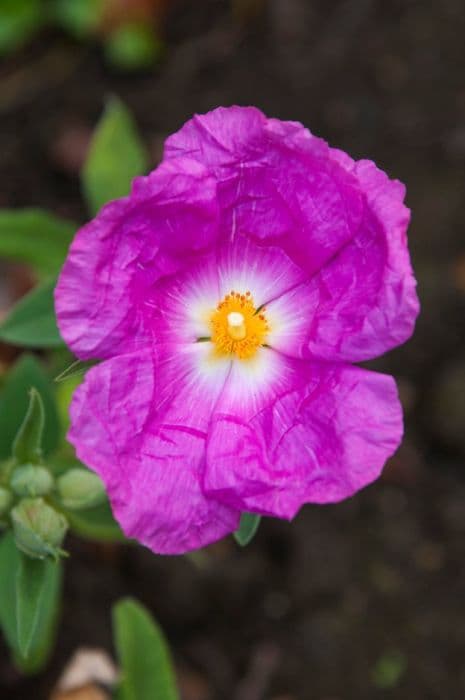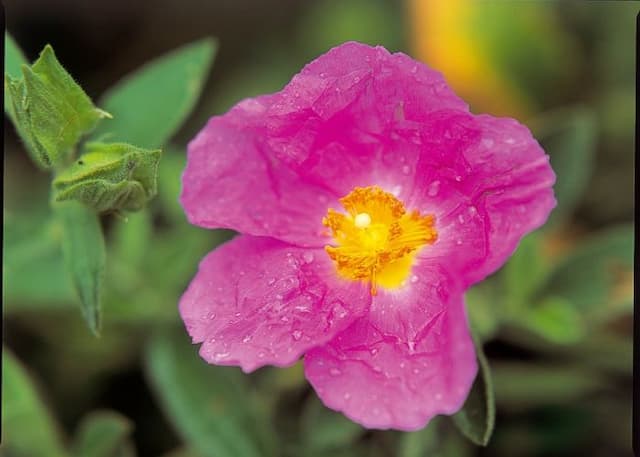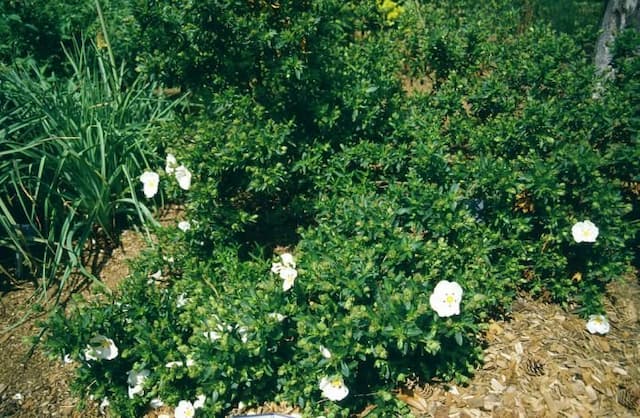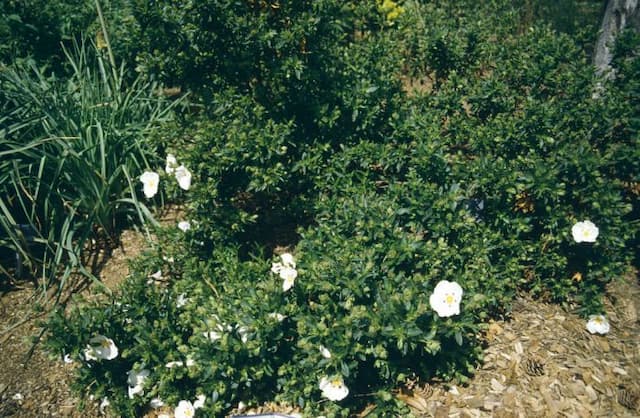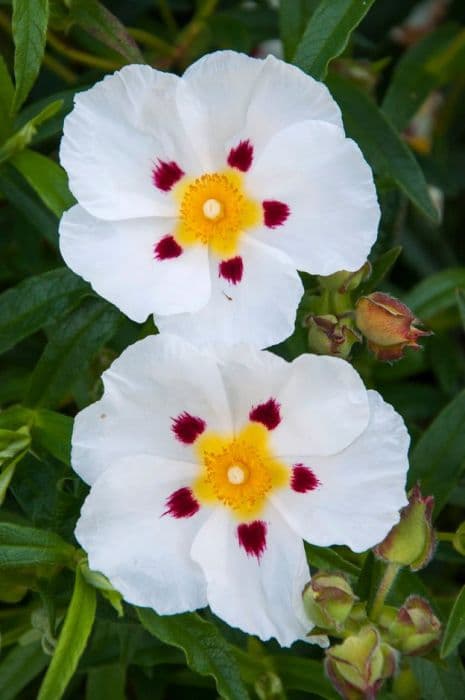Orchid Rockrose Cistus × purpureus

ABOUT
Cistus × purpureus, commonly known as the Orchid Rockrose, is a hybrid flowering plant with a robust and bushy appearance. It is recognized for its large, showy flowers that are similar in shape to roses. The Orchid Rockrose displays a deep purplish-pink hue with a pronounced spot at the base of each petal, typically a darker color which can be maroon or crimson. The petals have a delicate, tissue-paper-like texture that adds to the plant's aesthetic appeal. The foliage of the Orchid Rockrose consists of leathery, evergreen leaves that are dark green on the top and paler underneath. The leaves are arranged oppositely on the stems, and they possess a slightly sticky texture. The stems are woody and often covered with a downy or fuzz-like texture, giving the overall plant a rugged yet graceful look. The appearance of the Orchid Rockrose’s blooms is further enhanced by the numerous stamens, which are often a bright yellow color, creating a striking contrast against the deep purplish-pink of the petals. These blooms tend to appear in abundance and can completely cover the shrub when in peak flowering season, filling the surroundings with bursts of color. The blossoms typically have a subtle, pleasing fragrance that attracts pollinators and adds another layer to its garden appeal. Together, the vivid colors, attractive foliage, and bold, rose-like flowers make the Orchid Rockrose a stunning addition to any landscape where it can be planted in full sunlight, among other shrubs or in rock gardens, bringing with it a Mediterranean charm that is both resilient and easy to maintain.
About this plant
 Names
NamesFamily
Cistaceae
Synonyms
Orchid Rockrose, Purple-Flowered Rock Rose, Alan Fradd
Common names
Cistus × purpureus.
 Toxicity
ToxicityTo humans
The plant Cistus × purpureus, commonly known as the Orchid Rockrose, does not have significant toxicity to humans. It is not commonly reported to be a poisonous plant, and there are no well-documented cases or recognized symptoms of poisoning from ingestion of any of its parts. It is always a good practice to avoid ingesting plants that are not known to be edible, as they may cause unpleasant reactions or be toxic in large amounts.
To pets
The Orchid Rockrose (Cistus × purpureus) is not commonly known to be toxic to pets. There is no widespread evidence of poisonous reactions in animals like dogs and cats upon ingesting this plant. However, it's prudent to prevent pets from consuming ornamental plants as a general safety measure, as individual animals might have sensitivities or allergic reactions.
 Characteristics
CharacteristicsLife cycle
Perennials
Foliage type
Evergreen
Color of leaves
Green
Flower color
Purple
Height
3 feet (0.91 meters)
Spread
5 feet (1.52 meters)
Plant type
Shrub
Hardiness zones
8
Native area
Mediterranean
Benefits
 General Benefits
General Benefits- Landscape Beautification: Adds vibrant color and aesthetic appeal to gardens with its showy purple-pink flowers.
- Drought Tolerance: Once established, the Rock Rose requires minimal watering, making it suitable for xeriscaping and water-conserving landscapes.
- Low Maintenance: Requires little care beyond occasional pruning to maintain shape and encourage blooming.
- Attracts Pollinators: Its flowers are attractive to bees, butterflies, and other beneficial insects, supporting local biodiversity.
- Erosion Control: Its root system helps to stabilize the soil, making it a useful plant for slope stabilization and erosion prevention.
- Fast Growing: Rock Rose plants grow relatively quickly, leading to rapid coverage and gratification in garden settings.
- Deer Resistance: Generally resistant to grazing by deer, it is ideal for areas where deer predation is a problem.
 Medical Properties
Medical Properties- Antioxidant effects: Cistus × purpureus is believed to contain compounds that have antioxidant properties.
- Antimicrobial activity: Some studies suggest that extracts from the plant may inhibit the growth of certain bacteria and fungi.
- Anti-inflammatory properties: There is some evidence that Cistus × purpureus may help reduce inflammation in the body.
 Air-purifying Qualities
Air-purifying QualitiesThis plant is not specifically known for air purifying qualities.
 Other Uses
Other Uses- Cistus × purpureus, commonly known as Rockrose, can be used in the creation of perfumes due to its distinctive aromatic resin.
- The sticky resin secreted by Rockrose, known as labdanum, is traditionally collected and used as a flavoring agent in food and beverages.
- Rockrose plants are excellent for erosion control on slopes and embankments because of their extensive root systems.
- The ornamental appeal of Rockrose makes it a popular choice for themed gardens, such as Mediterranean or drought-resistant landscapes.
- Due to its dense growth, Rockrose can be used as a natural privacy screen or hedge in landscaping.
- Gardeners might use the dried flowers of the Rockrose for craft projects or potpourri to provide a natural fragrance to the home.
- Rockrose's tough and leathery leaves can be utilized in floral arrangements, providing a hardy foliage backdrop for more delicate flowers.
- Rockrose has been used to create a natural dye for fabrics, yielding colors in the beige to green spectrum depending on the mordant.
- The shrub's rapid growth and low maintenance make it suitable as ground cover to suppress weeds and reduce garden maintenance.
- In rural areas, Rockrose is sometimes planted as a firebreak because it is relatively fire-resistant once established.
Interesting Facts
 Feng Shui
Feng ShuiThe Rockrose is not used in Feng Shui practice.
 Zodiac Sign Compitability
Zodiac Sign CompitabilityThe Rockrose is not used in astrology practice.
 Plant Symbolism
Plant Symbolism- Survival and Resilience: Cistus × purpureus, commonly known as the Orchid Rockrose, is adapted to survive in challenging conditions such as poor soil and drought. Its ability to thrive in difficult environments makes it a symbol of survival and resilience.
- Beauty Amidst Adversity: Despite growing in harsh conditions, the Orchid Rockrose produces beautiful purple flowers, symbolizing the idea that beauty can exist even amidst adversity.
- Healing and Restoration: The plant has been used in traditional medicine for its healing properties, therefore it symbolizes healing and restoration.
- Renewal: Orchid Rockrose is one of the first plants to reappear after wildfires, representing renewal and the cycle of life and nature's ability to regenerate.
- Fleeting Nature of Life: The flowers of the Orchid Rockrose often last only a day, which serves as a reminder of the transient nature of life and the importance of cherishing each moment.
 Water
WaterThe Rock Rose should be watered deeply but infrequently. Established Rock Roses are drought-tolerant and do not require frequent watering. During the growing season, water the plant once every two weeks with about 1 to 2 gallons per plant, ensuring that the soil is allowed to dry out between waterings. In the winter, reduce watering to once a month or less, depending on the climate. Overwatering can lead to root rot, so it is important to let the plant dry out between waterings.
 Light
LightThe Rock Rose thrives in full sun conditions. It prefers to be placed in a location where it will receive at least six hours of direct sunlight every day. The plant can tolerate partial shade, but flowering is best in full sun. Do not plant Rock Roses in deep shade as this will hinder their growth and reduce flowering.
 Temperature
TemperatureThe Rock Rose is hardy and can withstand temperatures as low as 20 degrees Fahrenheit for short periods. The ideal temperature range for this plant is between 50 to 75 degrees Fahrenheit. It can tolerate some heat as well, up to about 100 degrees Fahrenheit, but might require some shade during the hottest part of the day in very hot climates.
 Pruning
PruningPruning the Rock Rose is generally done to shape the plant and remove any dead or damaged branches, which promotes new growth and better air circulation. Prune immediately after the flowering period ends, usually in late spring or early summer. This plant does not need heavy pruning; just a light trim to keep it tidy and encourage a second bloom in the fall.
 Cleaning
CleaningAs needed
 Soil
SoilRock Rose thrives in well-draining soil with added grit or perlite to enhance drainage. Aim for a soil pH between 6.0 and 8.0. A mixture of garden soil, coarse sand, and peat or a compost component works well for this Mediterranean native.
 Repotting
RepottingRock Rose does not need frequent repotting and can often be left undisturbed for several years. Repot only when the plant has outgrown its current container, typically every 3-4 years.
 Humidity & Misting
Humidity & MistingRock Rose prefers a dry climate and does well in low humidity environments that mimic its native Mediterranean habitat. Avoid overly humid conditions to prevent fungal issues.
 Suitable locations
Suitable locationsIndoor
Place Rock Rose in a sunny spot with minimal watering.
Outdoor
Plant in sunny area with good drainage and little water.
Hardiness zone
8-11 USDA
 Life cycle
Life cycleCistus × purpureus, also known as the Orchid Rockrose, begins its life as a seed that germinates in favorable conditions—moderate temperatures and well-drained soil are optimal. After sprouting, the seedling grows into a small plant through a vegetative stage, developing a root system and foliage. As the plant matures, it enters a flowering stage in late spring to early summer, producing vibrant purple or pink flowers with a distinctive dark red spot at the base of each petal. Once pollination occurs, usually by insects, the flowers produce small fruit capsules containing numerous seeds. The capsules release seeds when mature, allowing for dispersal and the potential for new plant growth in suitable habitats. Over the years, the Orchid Rockrose experiences repeated cycles of growth, flowering, and seed production, with these plants typically living for a period of about 5 to 10 years before concluding their life cycle.
 Propogation
PropogationPropogation time
Spring-Early Summer
Propogation: The Purple Rockrose (Cistus × purpureus) is most commonly propagated through semi-ripe cuttings taken in late summer. To do this, choose healthy, non-flowering shoots from the current year's growth and cut pieces about 4 to 6 inches (10 to 15 cm) long. Remove the lower leaves and dip the cut end in rooting hormone powder to encourage root development. Then, insert the cuttings into a well-draining soil mix, such as one part peat to one part perlite, and maintain a humid environment by covering with a plastic bag or placing them in a propagator. Keep the cuttings in indirect sunlight and ensure that the soil remains moist but not waterlogged. Rooting should occur within 6 to 8 weeks, after which the new plants can be potted on and gradually acclimatized to outdoor conditions.
